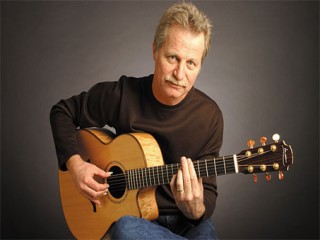
Alex De Grassi biography
Date of birth : 1952-02-13
Date of death : -
Birthplace : Yokosuka, Japan
Nationality : American
Category : Arts and Entertainment
Last modified : 2011-11-09
Credited as : guitarist, ,
0 votes so far
Grassi began playing guitar at the age of thirteen. At twenty-one, the self-taught guitarist drifted around Europe playing in folk clubs and subways. Not considering music as a career, de Grassi returned to the United States to study carpentry under his cousin Will Ackerman at Windham Hill Builders from 1974 to 1977. Working as a carpenter and attending school at the University of California at Berkeley, de Grassi continued to play his guitar, but, like his cousin, played only for friends and at private gatherings. Finally, upon the strong urging of these friends, Ackerman founded Windham Hill Records and began recording. De Grassi entered the studio to record for what was originally to be an anthology of fingerstyle guitarists for the label, but the resulting sessions brought forth his 1978 debut, Turning: Turning Back .
"His Turning: Turning Back LP is a classic of the genre," Underwood lauded. "Initially, one might think de Grassi has overdubbed two or more tracks--not so: one man, two hands, one guitar." In Folk Scene, critic Mark Leviton proclaimed de Grassi's first album "as fine a solo guitar disc as I've heard. He slips in and out of rhythms effortlessly.... When he casually throws in harmonics in difficult places, as in 'Window,' he is truly breathtaking." Underwood defined the style that culminated in such moments: "De Grassi has mastered the art of playing melodies, countermelodies, harmonies, and intricate rhythms simultaneously. His touch is as exquisite as his lyricism, and his improvisational/compositional musical consciousness is as intricate and subtle as sparkling crystal."
De Grassi continued this linear, almost meditative style on his follow-up album, Slow Circle, which received warm reviews. This time, however, there were detractors like Down Beat contributor Elaine Guregian, who wrote, "De Grassi's music irritated me (but gently) with its complacency." After her self-confessed "cavilling," Guregian conceded that de Grassi "plays beautifully, sometimes awesomely facile with his inventive lines. This guitarist has the ability--which many others lack--to use the device of repeated fragments without becoming derivative. There are many moments of achievement on this recording."
Despite such accolades, de Grassi never fully offered this style of playing again. On his 1981 release, Clockwork, most tracks feature the guitar in combination with piano, percussion, bass, violin, saxophone, and other instruments. "I wrote a lot of the pieces for Clockwork with specific instruments in mind," de Grassi explained to Dan Forte in Guitar Player . "I used the guitar more as a compositional tool." He also began experimenting with different musical styles--such as South American music--that have informed his work since.
In his last album on the Windham Hill label, Southern Exposure, de Grassi returned to the solo acoustic guitar, but also moved further away from his original compositional technique. He described the evolution to Forte: "On the first two albums, the tuning really determines a lot about how the music is. By the time of Southern Exposure, where I'm using both open and standard tuning equally, the musical idea dictates the tuning more." Forte felt the album signaled the maturation of the artist and was "possibly de Grassi's most realized work as a composer and guitarist. The songs are less stream-of-consciousness, more melodic; the playing is cleaner in execution and clearer in tone."
As illustrated in the title of his fifth album, Altiplano, de Grassi continued to seek direction and influence from South American music, as well as other sources. Jas Obrecht, writing in Guitar Player, observed that the "project features an eclectic array of instrumentalists ... and often couches the guitar in a supporting role. While a couple of tracks are reminiscent of his earlier work, de Grassi ventures into jazz, Brazilian, Middle Eastern, and pop flavors." Trying to expand on his compositional abilities, de Grassi pointed out to Obrecht, "I want to feature the guitar, but not necessarily have it dominate each piece." A concert appearance in support of this album, however, failed to convince a reviewer from the New York Times of the validity of de Grassi's explorations. Jon Pareles felt de Grassi's group "showed that eclecticism doesn't guarantee musical substance" and that as de Grassi "blended in with the band, a listener half expected a soloist to come on stage and do something against the pretty backdrop."
Selective Works:
-Turning: Turning Back, Windham Hill, 1978.
-Slow Circle, Windham Hill, 1979.
-Clockwork, Windham Hill, 1981.
-Southern Exposure, Windham Hill, 1984.
-Altiplano, Novus/RCA, 1987.
-Deep at Night, Windham Hill, 1991.
-The World's Getting Loud; Windham Hill, 1993
-Beyond the Night Sky: Lullabies for Guitar; EarthBeat!, 1996
-Alex de Grassi's Interpretation of Simon & Garfunkel; NorthSound, 1997
-Alex de Grassi's Interpretation of James Taylor; NorthSound, 1998
-The Water Garden; Tropo Records, 1998
-Bolivian Blues Bar; Narada, 1999
-Tatamonk (with Quique Cruz); Tropo Records, 2000
-Shortwave Postcard (with g.e. stinson); Auditorium, 2001
-Now & Then: Folk Songs for the 21st Century; 33rd Street, 2003
-Pure Alex de Grassi; Windham Hill, 2006
















